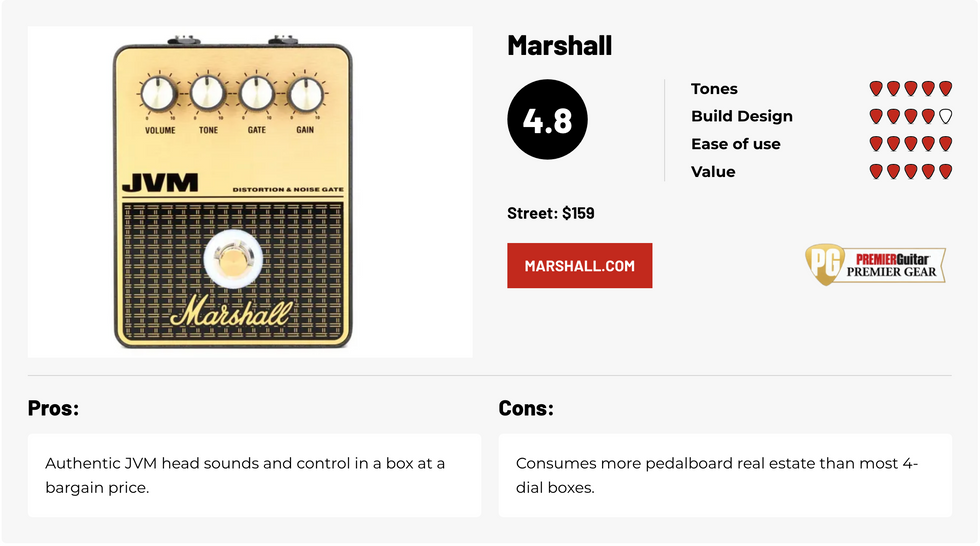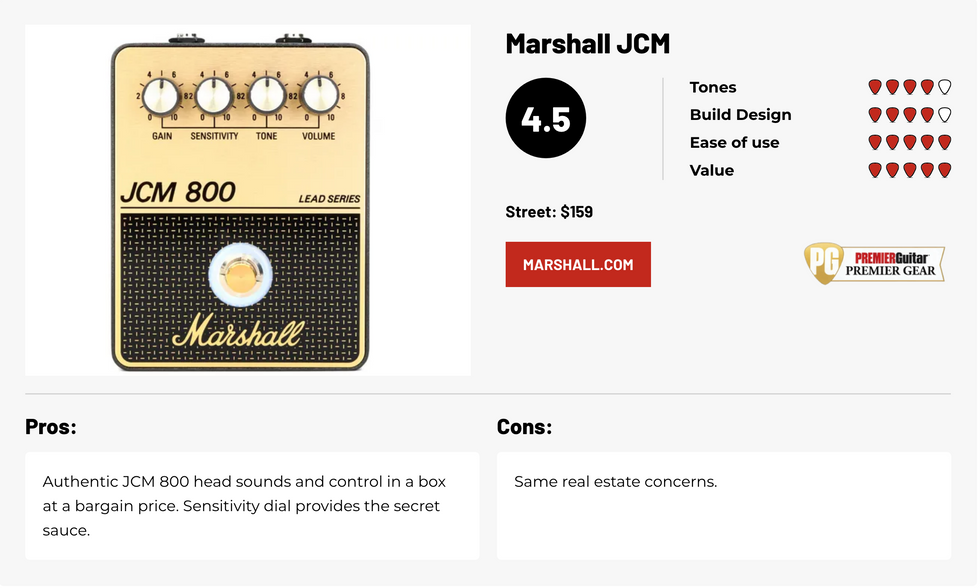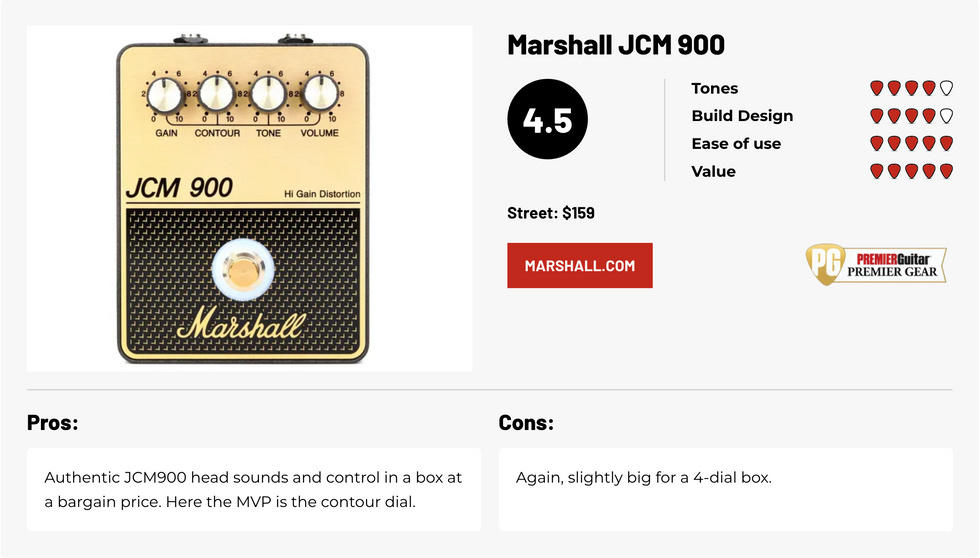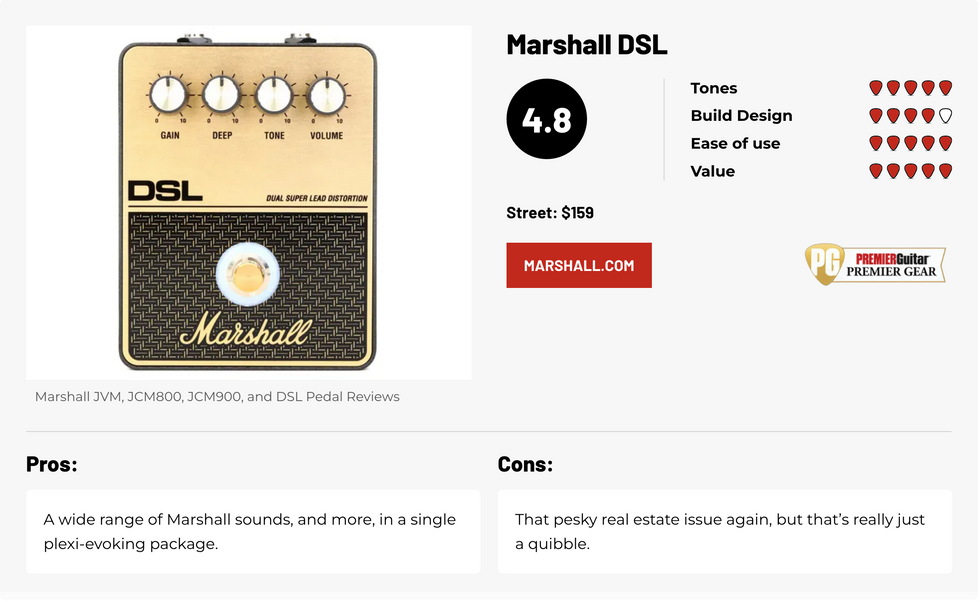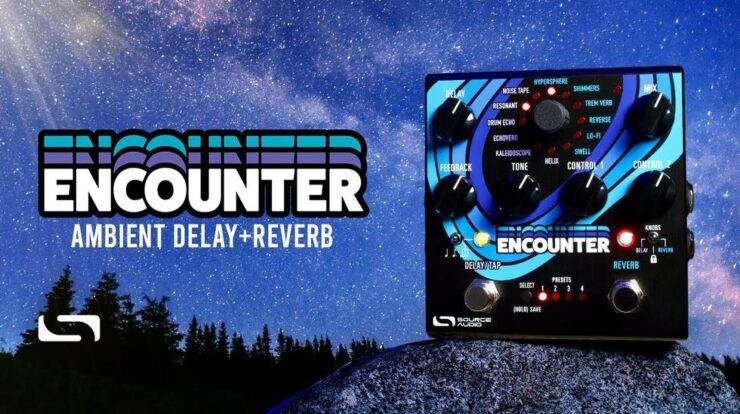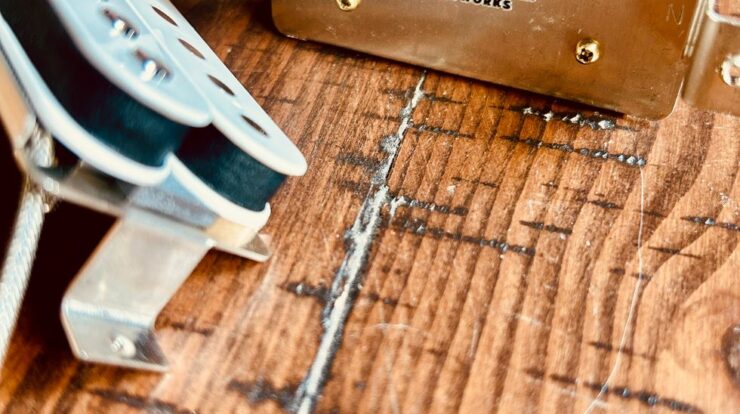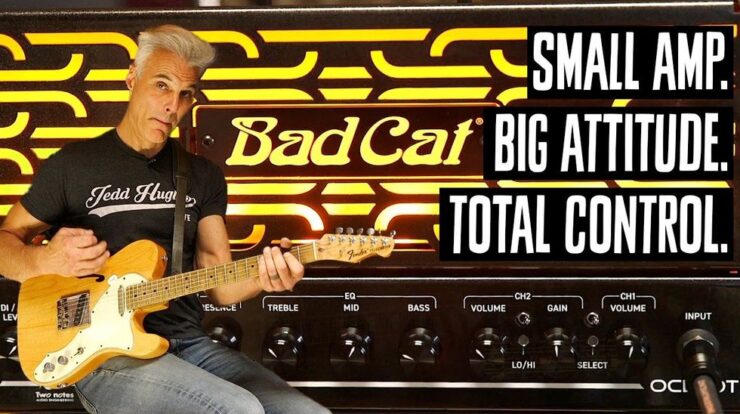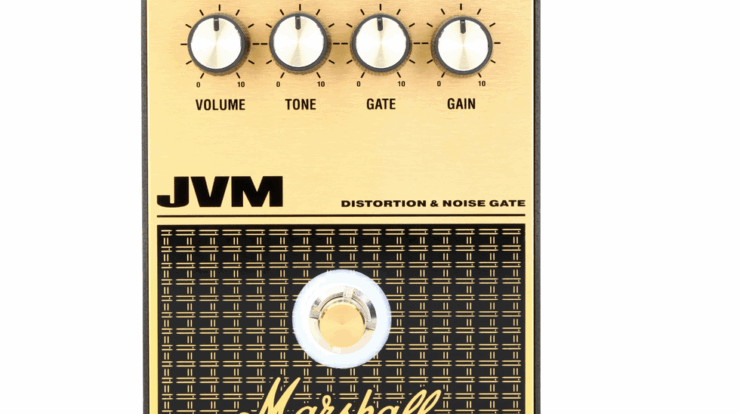
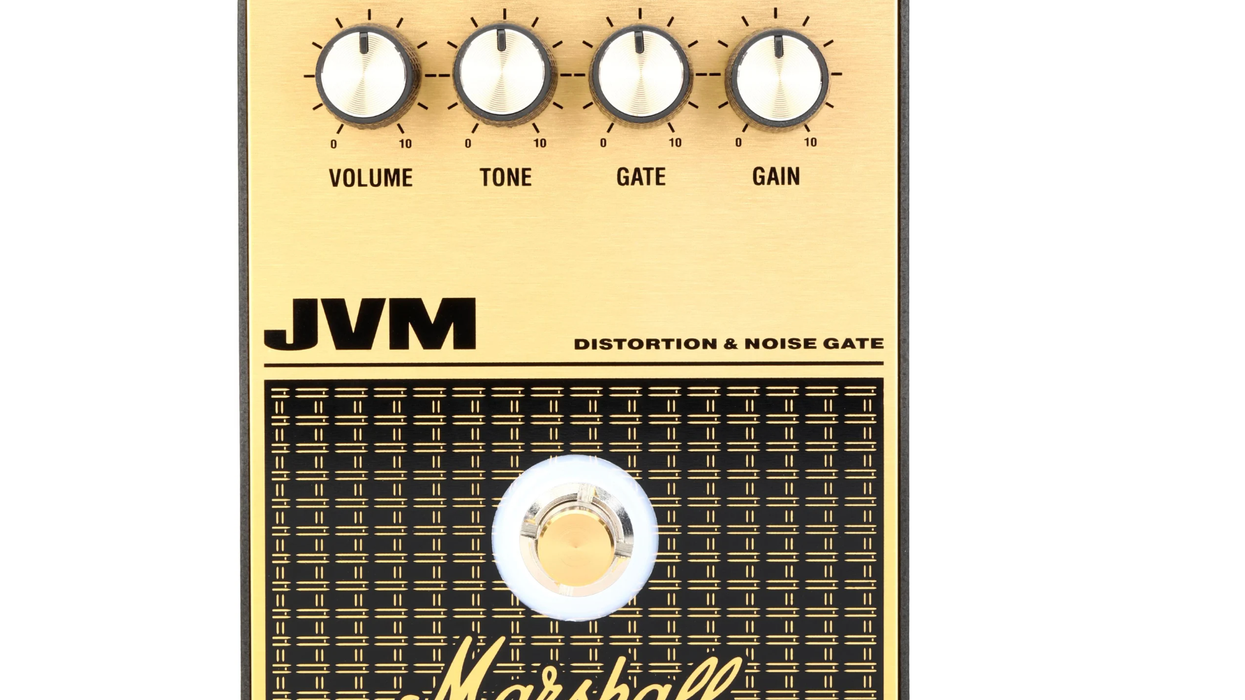
Marshall enters the amp-in-a-box ring with a series of true heavyweights that punch hard but can also dial back.
If you’d like to own a stable of classic Marshall heads but your budget won’t say “yes,” the legendary UK company may have a solution in the form of their recent line of amp-in-a-box overdrive pedals. They’ve put five of their greatest hits—the Super Lead (reviewed separately in our July issue), the JCM900, JCM800, the DSL, and the JVM—in 5″ x 4″ x 1 1/2″ stomps, with a black-and-gold panel-and-grille-cloth motif. Sonically, they range from “nailed-it” to stunning. And at $159, all four total less than the tab for a 100-watt DSL head and just a bit more than the 20-watt version, to say nothing of the $2,899 it takes to grab a new JCM800. With this snarling, all-analog, true-bypass quintet, all you need is a solid pedal-platform amp and a humbucking or single-coil 6-string, and you’re in business.
Admittedly, my test amps were very solid: a Carr Vincent and the company’s Telstar. But I also have extensive experience with 800s and Super Leads, and I know a good time when I hear it. Whether spanking a PRS SE Silver Sky, a ’68 Les Paul Standard, a custom Zuzu with coil-splitting, or a been-through-Hell Tele with humbuckers, the results are gritty and sparkling, with rich midrange tones and plenty of articulate brightness in these pedals’ simple controls. And while these creations take a standard barrel-pin connector, they also run on 9-volt batteries, which makes them an easy drop-and-go asset for backline gigs.
JVM Distortion & Noise Gate
Generally, I’m a low-to-medium gain player…until I plug into a Marshall. At club and practice room volumes, I like to crank the gain all the way, use the master to set my level, and then adjust the tones with a prejudice toward floored mids, or close to that, and highs somewhere around 2 or 3 o’clock, depending on the amp and guitar combination. This modus operandi paid off immediately with the JVM. In fact, it was a rewarding strategy for each of these pedals.
What’s appealing to guitarists like Joe Satriani about JVM heads is their blend of controllability, touch response, grit, warm midrange, and singing sustain. The JVM has its grounding in the kind of classic Marshall tones initially made by the Super Lead, but with extra sizzle and snap via a lot of smooth, highly controllable, well-balanced gain.
Strapping in for a flight with all these pedals is the very definition of plug and play. The JVM has just four dials: volume, tone, gate, and gain. The gate is perfectly effective. If you’re cranking the gain, just dial up the gate until the hiss disappears. And unlike many gates, it leaves your core tone shining. The tone control has range enough that the amp’s 3-band EQ is not missed (at least by me). And while the pedal can get very loud, rolling back the gain to noon-ish and peeling off the gate creates nice low-gain-amp tones not typically associated with JVM heads. That makes this pedal a joy to play and, whether you’re a high-gain or low-gain partisan, gives it the potential to lead you to tonal places outside your usual wheelhouse.
Ratings
JCM800 Lead Series
This is a pedal version of Marshall’s flagship ’80s head that helped produce many of that decade’s defining guitar voices—most notably, perhaps, Slash’s. Like the other boxes in Marshall’s new silicon-based overdrive stomp series, it rekindles those voices admirably. Its overall sound is a little looser than the JVM pedal, with a somewhat darker character, which might make it an appealing Marshall gateway for players who typically go low-gain but yearn for a taste of the wild side.
The JCM800 has plenty of controllability and volume in its 4-dial setup. Here, the knobs are gain, volume, and tone, naturally, with the addition of sensitivity. Sensitivity isn’t the same as presence, which boosts upper-midrange and treble frequencies. Instead, the sensitivity dial controls the amount of signal that goes into the preamp stage of an amp. The higher it’s turned, the more tube saturation and gain. (In older Marshalls, this aspect of tone coloration was often accessed by jumping the high and low inputs of amps like the Super Lead with a short cable.)
Keep both this dial, which emulates that process, and the gain low, and the JCM800 pedal takes a softer route, with less growl and a looser response to your fingertips and picking. Turn it up and the sound becomes nasty and more harmonically rich and reactive. In my opinion (and I toured with a JCM800 for years), these amps and this pedal have a buzzing quality in their sonic character until the gain is pushed to 2 or 3 o’clock, the tone past noon, and, in the pedal’s case, the sensitivity moves to about 2 o’clock. At these settings, the volume needs to rise to about 10 o’clock or better for the tone to open up, and that’s really pushing it in smaller rooms. But there are some great voices in the blend, and setting sensitivity to 10 o’clock, cranking the gain all the way, moving the tone to 1 or 2 o’clock, and the volume to 3 or so delivers lovely hard-rock crunch. Of course, that’s all subjective and influenced by what amp you’re pushing these pedals through, so the best test, as always, is firing one up for yourself.
Ratings
JCM900 Hi Gain Distortion
To my ears (and fingers), JCM900 heads have a tighter sound and are more responsive to your hands than 800s. I got the same impression playing this pedal too, which makes the JCM900 more genre-flexible, in my book. The secret sauce in this stompbox is administered via the contour control, which joins the gain, tone, and volume dials. Turn it down and the mids become scooped; turn it up and they are pushed to the fore.
This box is capable of tight ’80s and ’90s rhythm sounds, with the gain at 3, contour at 6, tone straight up, and the volume wherever makes you happy. Overall the tones are sparkling and snappy. Push the contour higher and mid-heavy lead sounds soar out, especially with the tone past 2 or 6 o’clock. This territory is blues-rock paradise. But my favorite setting was with the gain full-on (of course), the contour and tone around 1 o’clock, and the volume at 11 o’clock, crafting a blend of tough, biting, and sweet. I didn’t find the JCM 900 as versatile as the JVM or DSL pedals, but it’s nonetheless a charmer and, depending on your palate, may be perfect for your tastes.
Ratings
DSL Dual Super Lead Distortion
Introduced in 1997, the Marshall DSL, or Dual Super Lead, was designed to be a 2-channel Clydesdale. It’s the amp that embraces the widest spread of classic Marshall tones. Its vocabulary nods to all its heavyweight predecessors, and it’s capable of sounds that are clean and ringing as well as gnarly distortion. That versatility makes it a good partner for just about any style except folk music, unless you like your folk with a lotta attitude. (On the jazz side, Sonny Sharrock, who was a JCM800 player, would have dug this amp, too.)
This pedal is patterned on the amp’s second channel, which gleefully leans into higher gain and distortion levels. Setting the dials—gain, deep, tone, and volume—at 11, 10, noon, and 3 o’clock respectively delivered the sort of scalding, dirty rhythm sounds I associate with Pearl Jam. But turning the volume back a bit, I was reminded of a Fender Bassman with an overdrive pedal in front. In fact, on all these pedals, volume and gain are satisfyingly interactive, just like the amps that serve as their foundation.
For the DSL stompbox, the deep dial also plays an important role in this sort of mimicry. It is a low-end boost, which is especially valuable at quieter volumes, adding, well, depth, as advertised. Between the depth and tone control, the pedal offers a wide range of sonic character. And, of course, with the gain floored, it burns.
Playing through Marshal’s JVM, JCM800, JCM900, and DSL Pedals was an absolute delight, like having a fleet of toothy, world-class amps at my disposal. And they come at a bargain price. I recommend treating yourself to your own test flight as soon as possible.

